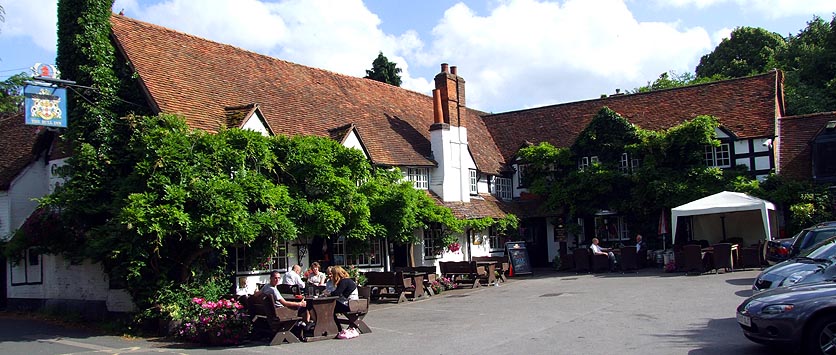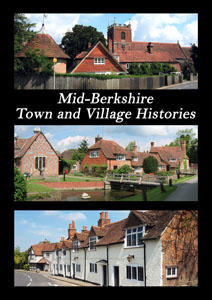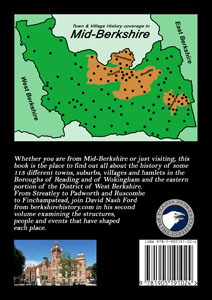 |
 |
||||||||
|
|
Sonning This well-known bridging point on the River Thames may well date back to Roman times, for there appear to be signs of a Roman road heading this way across Southern Oxfordshire from Wallingford. It may have then been a simple series of fords between the river islands. It was certainly well established during the Anglo-Saxon and then medieval periods when Sonning became an important crossing point for merchants and traders travelling from London to Oxford and the West Midlands. The bridge is not mentioned in extant records until the 1530s however. It had a toll, so there was also a cheaper ferry service up until 1835. The present brick bridge of twenty-seven bays was built to replace its wooden medieval predecessor in 1773. The mill complex on the island in the river, is of a similar date. This stands in what was the Oxfordshire section of the old parish of Sonning, now the parish of Eye and Dunsden. Prior to 1866, Sonning was a cross-county parish incorporating parts of both Berkshire and Oxfordshire. The name Sonning means [Place of] Sunna's People. Sunna is thought to have been an Anglo-Saxon chief whose people were widespread in Eastern Berkshire. Their other settlements included Sindlesham (near Wokingham), Sunninghill and Sunningdale (near Ascot), and also Sunningwell (near Abingdon). Sonning was the capital of Sunningum, an administrative province in the late 7th century. Sonning's importance is shown by the fact that it was chosen as the site for an Anglo-Saxon minster from where priests would travel out into the surrounding countryside to preach to the locals. Sonning Minster's territory originally covered Wokingham, Hurst, Ruscombe, Sindlesham, Arborfield and Sandhurst, as well as Sonning itself, and these places did not gain their ecclesiastical independence until the 14th century. In AD 909, Sonning Minster was converted into one of the twin cathedrals of the newly created Diocese of Ramsbury & Sonning. Sculpted fragments of the old cathedral can still be seen built into the present church. A bishop's palace was built alongside, where holy men such as St Bertwald, St Aelfstan, St Oda and two other future Archbishops of Canterbury often resided. The bishops seem to have made Sonning into something of a pilgrimage centre, for the church held a relic of St 'Sarik' (possibly St Cyriacus). There was still a chapel dedicated to him in existence around 1600, which may have been immediately behind the chancel. The Sonning Diocese was eventually united with Salisbury (Wiltshire), but the bishops continued to live at Sonning on occasion and the complex was much expanded, particularly upon its crenellation in 1337. St Osmund owned the manor at the time of the Domesday Book (1086) and, as he is known to visited the area, so probably resided there quite often. Bishop Roger of Salisbury is known to have stayed at the palace while attending the funeral of King Henry I at Reading Abbey in 1135. In 1216, Bishop Herbert Poor acted as custodian, at Sonning, for at least one of King John's noble prisoners and the King himself arrived to receive his ransom money there. The seven-year-old Princess Isabella of France, became a further prisoner at the Bishop's Palace upon her husband Richard II's deposition in 1396. She was visited in her splendid gaol by his supporters, hopeful of his restoration, but their 'Epiphany Rising' came to nothing. Isabella later returned home, across the Channel, though her ghost is said to still walk the fields over the palace ruins at Sonning. King Richard's personal symbol was the white hart (a pun from Rich-Hart) and was long reflected in the name of a local Sonning inn, now unfortunately renamed the Great House. There is nothing to be seen of the old Bishop's Palace today but a Tudor wall and a low mound near Holme Park. However, the 16th century Bull Inn is thought to have been the bishops' guesthouse where St Sarik's pilgrims stayed. Its name stems from the bovine supporters and crest of Sir Henry Neville who was the steward to Queen Elizabeth I at Sonning after she bought the manor from the Bishops of Salisbury. The parish church was owned directly by Salisbury Cathedral. Its dean, as official rector, had an occasional residence, Parsonage House, at Sonning from about 1284 until the 1660s, although he was rarely in residence. Deanery Garden, a masterpiece of Arts-and-Crafts architecture by Sir Edwin Lutyens still stands on its site north of the church. The present church at Sonning, though considerably restored in Victorian times, is largely 13th and 14th century in date. It houses a fine collection of monuments. There is a superb brass to Laurence Fyton (1434), who was the Bishop of Salisbury's bailiff, running the Sonning estate on a day-to-day basis between intermittent episcopal visits. Further 16th century brasses and later monuments are to the Barker family, royal under-stewards at Holme Park and later owners of the old Parsonage House. Only a small group of six kneeling figures remain of what must have originally been a fine Jacobean monument, to the Blagraves of Bulmershe Court in Woodley. They were found in the old family vault. The most striking monument, however, must be that to Sir Thomas Rich (1667). This extraordinary memorial features four cherubs supporting two large urns. It has been described as "the vilest paganism imaginable" but would have been the height of fashion at the time. Rich traded in wine in Turkey and lent the King large sums of money during the Civil War. He bought Sonning manor, by then called Holme Park, in 1654. He became a great patron of the Reading Blue Coat School, now housed in the second successor to his own home, a house built for Henry Golding-Palmer in 1880-2. During the Napoleonic Wars, Viscount Sidmouth's house on the High Street, The Grove, was the prison of Admiral Villeneuve, the French commander at the Battle of Trafalgar. Towards the end of his life, Pre-Raphaelite artist, William Holman Hunt, came to live at The Acre in Sonning, where he painted his second version of 'The Light of the World'. A less salubrious residence, a cottage at the end of Sonning Lane called Turpins, is said to have been the home of Dick Turpin's aunt. Being frequently engaged on the Bath Road, Dick would flee the Berkshire authorities by galloping to his aunt's house, then on foot through the churchyard to Oxfordshire and safety. Black Bess would casually stroll down to a loose-box hidden below the cottage. Read more history of Sonning and other nearby settlements, like Charvil, Sandford, Newtown & Cemetery Junction, in David Nash Ford's book, 'Mid-Berkshire Town and Village Histories'. Click to Order direct from the Author.
|
||||||||
| © Nash Ford Publishing 2001; Revised 2020. All Rights Reserved. | |||||||||





